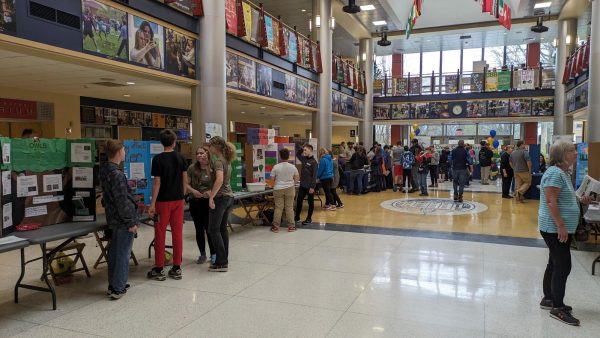Bentley Hall renovation nears completion
“After almost two years of work and delays caused by the current COVID-19 pandemic, the renovation of Bentley Hall is almost complete. In addition to improving the appearance of the structure, the project is also designed to modernize the building’s infrastructure and bring it in line with Allegheny College’s ecological goals. With most structural work complete, focus has turned to interior finishing and fixtures. Much of the building’s infrastructure, including the electrical, plumbing and mechanical system, will also be replaced.
Though delayed by stay-at-home orders and other COVID-19-related restrictions, Bentley is expected to be completed by October 30th and re-occupied for the Spring 2021 semester. The administration also expects that members of the Class of 2020 will be able to walk through the building during their commencement exercises in late November, in accordance with Allegheny tradition.
To find out more, read the full article linked below or visit alleghenycampus.com. Story and photos by Sami Mirza”
After almost two years of work and delays caused by the current COVID-19 pandemic, the renovation of Bentley Hall is almost complete. In addition to improving the appearance of the structure, the project is also designed to modernize the building’s infrastructure and bring it in line with Allegheny College’s ecological goals.
“This isn’t just a face-lift. This is a full-body-lift,” said Cliff Willis, director of major capital projects of Allegheny College.
Originally built in 1820, Bentley is one of two buildings on campus listed on the National Register of Historic Places; the other being Ruter Hall. Until Ruter’s construction in 1853, Bentley was Allegheny’s only building. The structure’s age — more than two centuries — was one of the major reasons why the project was undertaken in the first place.
“Bentley had a last major renovation in 1924-1925, and since then there have been some minor renovations that have taken place, but over time, systems get tired and worn-out,” said Willis, who is overseeing the project. “The building, being 200 years old now, has endured the Meadville winters for 200 years, which really taxes the structure.”
The workers first removed the interior structure, gutting the building. They then reinforced the base by injecting grout — a mixture of cement, sand and water — into gaps between the foundation stone and adding steel supports to the interior of the building. Bentley’s two-century-old slate roof and all eight of its chimneys were replaced. A white pine on Bentley’s grounds, killed by a lightning strike, was used to re-roof the west wing of the building
“Primary structural work is done,” said Willis. “Now we’re doing finishes.”
The interior walls, wallboards and ceilings still need to be put in. Locations for new outlets and data ports must be found, part of the facility’s new infrastructure. The electrical system, previously routed through Brooks Hall, now runs through an independent transformer on Bentley’s grounds. The plumbing, mechanical and sprinkler systems have also been replaced. 12 new geothermal wells, dug along the north side of the building, will add cooling to Bentley for the first time in the structure’s history.
“The earth’s temperature stays pretty constant and so in warmer weather, cooling fluid goes down into the wells and releases the heat (and) transfers the heat into the surrounding earth,” Willis said. “In the wintertime … you get a transfer of warmth from the ground into the liquid system. That’s supported by mechanical equipment in the attics of each wing of Bentley,”
The addition of geothermal energy to Bentley represents another goal of the project: renovating the structure to match Leadership in Energy and Environmental Design specifications.
“We really are interested in taking the very historic, and in many cases, beautiful footprint that we have and renovating those spaces not just to be up to full standards but also to reflect the sustainability that we care so much about,” President Hilary Link said.
Renovation for LEED certification, while indicative of environmentally-minded design, comes at a higher price than standard remodeling. According to HPAC Engineering, building to LEED standards can increase building costs by 10 to 30%. None of this, however, came from Allegheny’s budget.
“When the current strategic plan was developed, the renovation of Bentley was included in that strategic plan,” Willis said. “However, it was designated a ‘donor-only project,’ so no college money was to be used for the renovation.”
In mid-March, pursuant to Governor Tom Wolf’s stay-at-home order, work was halted on Bentley. Work resumed in early May, a little less than two months later, with daily temperature checks, symptom checks and a revised shift system that limited worker contact. The pandemic has undoubtedly slowed the project down: Bentley’s completion, once slated for last month, is still uncertain.
“We have a rough idea, and not to avoid the question, but one of the other impacts we’re finding from the pandemic is a slowdown in the supply chain, and also a lack of availability of certain things … so, once Massaro (the construction company) came back to work, we sat down and I required them to give me a new schedule for completion,” Willis said. “That new schedule showed the 30th of October as the completion date. What we’re finding out now is that we think we’ll have most of the work done by the 30th of October, but there are a couple activities that will extend into November and possibly a little later than that.”
Even if construction is completed by the end of this semester, President Link said the move-in process would commence once students have left campus.
“The move will happen some time in, we hope, December, so that when we re-open in 2021 everyone is settled,” Link said.
By December, Bentley will have been out-of-use for just over 27 months — two and a quarter years. Although out of commission for five semesters, the building is still important to students.
“I know many students , when they got de-comped, even when it was under construction, they took their pictures outside of it, just to affirm that they were done,” Jasmine Ramirez, ’21, said.
Bentley is typically home to much of the administrative staff at Allegheny, including the Office of the President and Human Resources. When renovation began, those administrative offices moved to other facilities like the Tippie Alumni Center, Murray Hall and the Henderson Campus Center, pushing out some student groups in the process.
“When Bentley started to get remodeled, they moved [the offices of the multicultural organizations] to Brooks in a little, really small room,” said Ramirez, a member of Union Latinx and President of Latinas on the Rise. “I’m going to be honest, I’ve never been there … And a lot of students did complain just because they put (most of the cultural) organizations in one small room, so that was really inconvenient. “
Still, Ramirez is optimistic for the project’s completion. Given the current pandemic, she did not expect to see the completed renovations before she graduates next spring.
“I feel like once that building’s done, it’s going to be a relief and we’re going to have more space as well, especially now that we’re doing all these classes in open spaces,” Ramirez said.
The class of 2020 is expected to revive the tradition of walking through Bentley before graduation when they hold their commencement in late November, according to Link. The last class to walk through Bentley was the class of 2018, who graduated before construction began.
“We are doing our best to create an opportunity for them to have that moment, which, interestingly, they actually would never have had if COVID hadn’t happened,” Link said.
Overall, Link considers the project a success. Although delayed because of the current pandemic, it has stayed within the planned budget and has hit all the goals related to sustainability.
“The fact that we have successfully been able to retrofit Bentley to be LEED certified, and to have the geothermal heating, it is no small feat in a 200-year-old building,” Link said. “Given that we’ve managed to do that within budget, managed to actually pull that off logistically and structurally, I think it gives us a really good sense of how we would do this for other buildings in the future.”
One building Link immediately identified for renovation was Reis Hall, which sits across the Brooks Walk from Bentley Hall. Reis, now only partially used, was the college’s library from its completion in 1902 until the construction of the Pelletier facility in 1976.
More visible indicators of progress include the replacement of windows with custom-fitted panes in the 6×6 format that was originally installed on the building. Between Oct. 5 and 23, community members can also expect to see the erection of the stairs leading up to the main entrances on the north and south sides of the building.

Sami Mirza is a senior from many different places. He is majoring in International Studies with a focus on the Middle East and North Africa and minor in...






